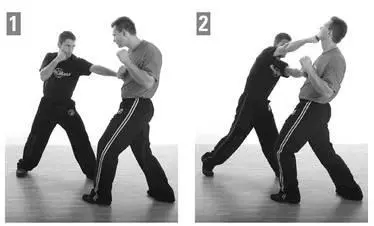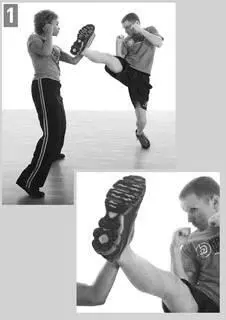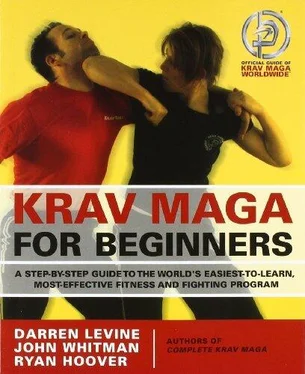KEY POINTS
• reach down and sweep your defending arm diagonally forward and across the line of your groin to redirect the kick
• blade your body—defending side forward—as a body defense
• bring your other hand up and across your face to protect against punches
• keep your defending arm straight from fingertips to shoulder (you may keep a small bend in your elbow to avoid hyperextension)
COMMONLY ASKED QUESTIONS
Can I use the same hand to defend either kick?
Yes. As with the Defense against Front Kick (page 119), the line of attack is the same with either kick, so you can use the same arm against either kick. This is helpful because of a basic assumption: We assume that we’re totally unprepared for this attack, and we’re standing in a neutral position. If this is true, there’s no time to recognize which kick is coming at us, so we must simply defend as soon as possible. Depending on the kick the attacker uses, you may end up on the live side and open to his additional attacks. This is why you must counterattack immediately and aggressively.
Why do we assume we are so late in doing this defense?
Although it works, this is not our most effective or comfortable defense. However, from a position of extreme disadvantage, reacting on instinct, this defense is closest to our body’s reflexive reactions (hands going down, hips going back).
Training Tips:Reach down so that you can defend the kick as early as possible. Reach slightly forward so that, if you’re fairly early, you can defend at the knee before the foot starts to rise.
Hand Defense against Groin Kick (Stabbing)
ATTACK→ The attacker throws a rising right kick to the groin when you’re in a fighting stance.
IMMEDIATE DANGER→ Being struck (rather painfully!). The primary danger is being hit.
SECONDARY DANGERS→ Disorientation, balance. Groin kicks are not always as bad as they appear in the movies, but they can cause a) pain that temporarily disables you and b) an instinctive reaction to put your hands down, scoot your hips back, and pinch your knees in to protect your groin, which can compromise your balance, leaving you open to additional strikes.
SOLUTION→ Outside Stabbing Defense against Front Kick
1As the attack rises, burst in toward the attacker on a slight diagonal angle and stab down toward the attack er’s knee with your rear (right) hand. Keep your elbow in and the meaty part of your hand pointing back toward your body. This ensures that your arm is straight, creating no angle against the kick. Keep your shoulders square to your attacker—turning your right side (the defending arm) forward will redirect the kick into your body, not away from it. Be sure your left hand is up, protecting your face, in case the kick is followed by an immediate punch. As soon as you feel the kick sliding along your arm, move the arm slightly outward, creating a larger defense.

INITIAL COUNTERATTACK→ Straight Punch. As you make the defense, burst in and trap the attacker’s arm with the non-defending hand (for most people, this will be the left hand) and deliver a counterattack with your right. Alternately, you can throw an immediate (even simultaneous) counterattack with your left hand. This is a much faster, but most likely weaker, counter.
NEUTRALIZING THE ATTACKER→ After the initial counterstrike, the defender should continue to strike to the body and face. Students must focus on rendering the attacker unwilling or unable to continue the assault.

KEY POINTS
• stab your rear hand downward, elbow in and down, to redirect the kick
• burst in as you defend
• keep your shoulders square so that the kick is redirected off your body
• keep your other hand up and slightly forward to protect your face
COMMONLY ASKED QUESTIONS
Should I always use my rear hand to make this defense?
Yes. The kick is redirected off your body. Using the rear hand means that the kick is redirecting toward the rear hip as well. Because that hip is back, there is space for the kick to travel through and then off the body. If you try to defend with the forward hand, your forward hip may be in the way, and you may take the kick on your body.
Is this defense better than the reflexive defense?
The stabbing action is stronger, and redirects the kick with a simpler motion. Basically, by stabbing, you are building a ramp that simply guides the kick away. In most cases, once you stab to the inside of the leg and the leg begins to slide up your arm, the kick is automatically redirected. The “sweeping” action of the reflexive defense works well, but isn’t quite so absolute.
Hand Defense against Front Kick to the Face
ATTACK→ The attacker throws a right rising kick to your face.
IMMEDIATE DANGER→ Being struck. The primary danger is being hit in the face.
SECONDARY DANGERS→ Disorientation, balance. Whether or not you actually take the kick, the attack may cause you to lean back, robbing you of balance and initiative.
SOLUTION→ Inside Defense against High Front Kick
1As the kick rises, bring your forward (left) arm across your face and upper body, parallel to the floor. Your hand may be in a fist—rotate it so that the meaty part of your hand makes the deflection. As you make the hand defense, add a small body defense by blading your body with the left side forward. Be sure your weight stays in the fight! Keep your hand up and your elbow inward so that your forearm is vertical. If you dip your hand down, you’ll make an angle against the attack and get kicked in the arm.
INITIAL COUNTERATTACK→ Straight Punch. Immediately counterattack, most often with a right straight punch.
NEUTRALIZING THE ATTACKER→ After the initial counterstrike, the defender should continue to strike to the body and face. Students must focus on rendering the attacker unwilling or unable to continue the assault.
KEY POINTS
• redirect the kick with the forearm of your forward hand
• blade your body to make a body defense
• don’t lean back; stay in the fight!

COMMONLY ASKED QUESTIONS
Should I always defend with my forward hand against either kick?
Yes. The line of attack is the same. Be aware that you may end up on the live side. Always counterattack aggressively and decisively.
I keep getting kicked in the arm. What’s wrong?
You’re probably defending by dropping your hand down. This usually results in a kick on your forearm. Redirect the kick by moving your forearm (hand up, elbow down) across your body.
Is it better to make a fist or leave your hand open?
An open hand will be more relaxed, and therefore faster. A closed fist will tense the muscles of the forearm and protect them in case your timing is off and you absorb any power from the kick. Therefore, both have pros and cons. Ideally, an open hand results in a faster defense.
Читать дальше















